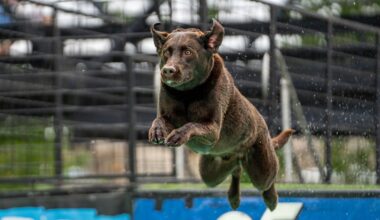Common Myths Leading to Puppy Potty Training Mistakes
One of the common myths about puppy potty training is that puppies intuitively know where they should relieve themselves. Many people mistakenly believe that dogs will naturally understand they need to go outside. This misconception can lead to confusion and accidents inside the house. Though some breeds might have better instincts, it’s crucial to recognize that puppies require consistent training. You must actively teach them the appropriate place to relieve themselves. By providing a structured environment and using positive reinforcement, you can help them learn more effectively. Owners should also consider that each puppy learns at different rates, and patience is essential. A lack of adherence to a consistent routine can lead to setbacks. Moreover, environmental factors play a massive role. For example, weather disruptions might affect your puppy’s willingness to go outside. Overall, teaching a puppy where to potty is a process that requires commitment. You’ll find that using praise, rewards, and eagerly taking them outside regularly will significantly enhance their understanding.
Another myth is that negative reinforcement is effective in potty training. Many owners mistakenly think that scolding or punishing their puppies for accidents helps them learn. However, this method can backfire and create fear or anxiety in your puppy. When this fear develops, your puppy may attempt to hide soiling indoors. Instead of learning, they may become secretive. Positive reinforcement techniques consistently yield better results. Praise, treats, and affection when your puppy goes potty outside serve as effective motivators. A well-structured system of rewards allows your puppy to associate going outside with great things, fostering a healthy and trusting relationship. Understanding your puppy’s body language can also offer insight into when they need to go out. Approach their training with love and encouragement instead of punishment. This shifts focus from fear to positive engagement, enabling a stronger bond between you. Remember that your puppy is learning and may not understand why accidents happen during this time. Adapting your potty training approach to focus on encouragement will pay off in the end. A confident puppy is likely to mature into a well-behaved adult dog.
Many believe that once potty training is established, it is permanent. This leads to a misconception that puppies will never regress. In reality, various factors can lead to setbacks or regression in potty training. Stressful environments, changes in routine, or medical issues can all impact a puppy’s ability to hold their bathroom needs. Additionally, puppies, just like humans, can experience fluctuations in learning. It’s essential to understand that these issues are natural and can happen. It’s advisable to remain vigilant as the puppy matures, revisiting training as necessary. Consistency is key during these times, as helping your puppy adapt back into the routine reinforces their learning. If regression occurs, keeping a positive attitude and reintroducing basic training principles can help. Furthermore, consult a veterinarian if you suspect a medical reason behind the regression. Health issues can manifest as frequent accidents. Being proactive supports your puppy’s well-being and training. In sum, maintaining a flexible training plan and adapting to any changes ensures ongoing success. Avoiding complacency in training will help fortify your puppy’s understanding of appropriate bathroom behavior.
Potty Training Myths and Misconceptions
A prevalent myth is that all puppies can hold their bladder for the same amount of time. In reality, puppies have different capacities based on their age, size, and breed. Some breeds are naturally predisposed to be more resilient, while others may struggle significantly. Young puppies, for instance, have limited control and typically need to relieve themselves every couple of hours. It’s crucial to tailor your expectations based on your puppy’s specific needs. Many owners may not recognize the signs of a full bladder in their puppies, leading to unintentional accidents. A better understanding of individual needs promotes a successful training experience. Create a schedule that aligns with your puppy’s capabilities. Observing routine patterns helps to establish positive habits. Moreover, remember that each puppy responds differently to training techniques. What may work for one may not work for another. If an approach feels ineffective, consider adapting your methods. Strategies like using a crate safely can create a sense of responsibility. Others might benefit more from scheduled outings. Personalizing the training experience is a powerful step in ensuring consistent advances.
It’s a myth to believe that once your puppy is potty trained, you don’t need to supervise them anymore. Continuous supervision becomes vital during their development phase. Even house-trained puppies will need guidance as they grow and learn. Supervision allows you to observe their habits and provide timely reminders to go outdoors. Relying solely on previously learned behaviors can lead to careless errors. Accidents could occur during exciting moments or changes in routine, reaffirming the need for vigilant observation. Events such as moving to a new home, changes in your work schedule, or introducing other pets can disrupt your puppy’s routine. With consistent monitoring, you can redirect your puppy when necessary, helping avoid mishaps. By maintaining a close eye on them, you can reinforce positive behaviors. This close connection can also provide comfort as they adapt to any changes. Using these opportunities to praise and reward your puppy strengthens their understanding of good habits. Your puppy should feel supported throughout this journey, creating a foundation for lifelong companionship.
Another misleading belief is that potty training will be the same for each dog, regardless of age. Each puppy’s past experiences will also significantly impact their response to training techniques. Puppies adopted from shelters or with unknown backgrounds may require extra attention. Their history could encompass fear or anxiety regarding bathroom habits. When incorporating training, it’s crucial to acknowledge these differences, sharing patience guided by understanding. Like humans, every puppy learns at varying rates, often rooted in prior experiences. While adjusting expectations for puppies is essential for success, also consider applying unique strategies regarding your pup’s past. Personal adjustments and tailored approaches become invaluable for dogs with anxiety. Essential techniques may require more time, but they will yield rewarding outcomes. Adapting your teaching style creates comfort for your puppy, helping them connect with their behaviors positively. Incorporating gradual exposure to new situations allows for effective learning. Dedicating time to work through these concerns builds trusting relationships, ensuring stability. Positive reinforcement, as always, leads to better long-term behavior.
Conclusion
In conclusion, understanding common myths about puppy potty training significantly enhances the experience. Dispelling these misconceptions allows for a more effective strategy towards successful training. Owners must use positive reinforcement throughout the process, avoiding negative behaviors that can hinder growth. By recognizing the individual needs of each puppy, their limits, and providing consistent supervision, you ensure their learning stems from positive experiences. Each step taken reinforces trust and reliability within the owner-puppy bond. Remaining patient and flexible during development leads to better results. Seeking guidance from professionals can also help clarify misunderstood aspects. The right information offers a clearer perspective on effective techniques. Remember, a well-trained puppy reflects not only your efforts but creates a better bond for both of you. From considering each puppy’s unique traits to consistently rewarding positive behaviors, every effort is integral to training success. Always adapt and respond to any changes in your puppy’s life while employing their past as a valuable training tool. Ultimately, the love and support you provide can help create a wonderful companion that fully integrates into your life.
Raising a puppy is a challenging yet rewarding experience, but one of the most critical aspects is proper potty training. Misunderstanding common potty training myths, such as assuming all puppies know where to go or relying on punishment, can hinder success. Mistakes often stem from misconceptions about behavior and the need for supervision. Realizing that regressions may occur and maintaining a flexible approach is vital to ensuring long-term success. Each puppy is unique, responding differently to various techniques. Personalizing training allows a better connection and fosters learning and trust. Supervising and recognizing your puppy’s signals help maintain your training efforts. Remember, as your puppy grows, so will their experiences. Adjust your approach as needed and always celebrate the small successes. Stormy weather, changes in routine, and life transitions may require your puppy to adapt, so be prepared for occasional setbacks. Additionally, never underestimate the value of consulting with experienced trainers or veterinarians for tailored advice. With patience, understanding, and proper techniques, you can create a strong foundation for your puppy’s lifelong behavior and cement the bond between you and your furry companion.


